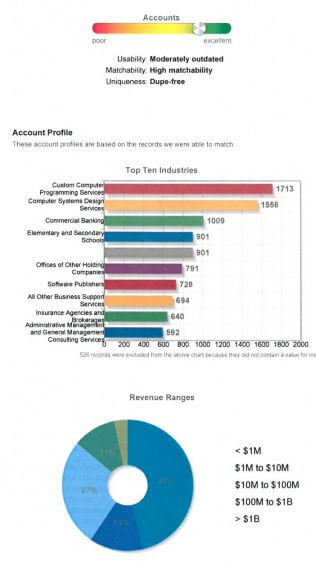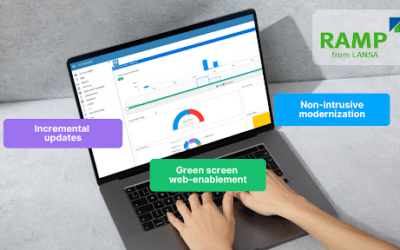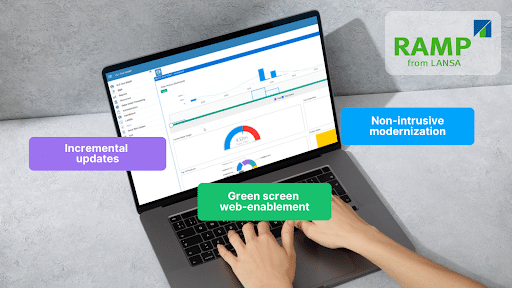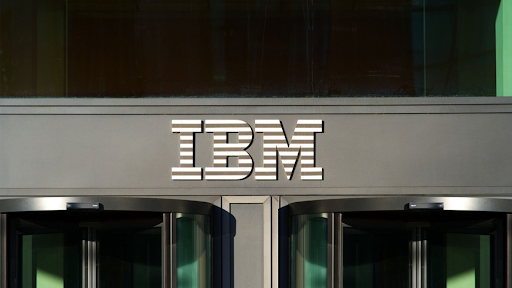Businesses are being bombarded with the message to modernize. In the IBM i world, most tend to define modernization in terms of low-level development tactics such as converting RPG to free form, updating databases to SQL or refacing 5250 screens for the web. While these tactics have technical merit, they do little to help IT provide an immediate competitive edge or improve the bottom line. It’s easy to lose sight of the business side of modernization when you’re so busy working on its technical aspects.
The industry has made modernization sound so complicated that no one wants to do it. But modernization isn’t only about technology; it’s about getting back to the basics. Instead of focusing on code and systems, successful modernization strategies cultivate a business-first mentality.
Think of online retail giant Amazon.com. The company’s consumer-first strategy has earned it 209 million users, who generated sales of nearly $90 billion last year. You’ve likely ordered from Amazon repeatedly, but how many times have you called customer service for help? Compare this number to the amount of calls your company receives daily from customers. Amazon’s ease of use has put the company consistently at the top for customer-service surveys.
While measuring yourself against Amazon is beyond the reach for many of us, the company provides proof that businesses who are easy to work with will often win out over the competition—even if they don’t have the best products or the cheapest prices. Today’s demands for instant gratification mean companies must facilitate transactions quickly and simply, or consumers will go elsewhere.
The goal of modernization is to use technology to best support your customers and trading partners—delivering the best user experience, enabling remote workers to access real-time data quickly, getting the right information into the right hands and continuing to improve business processes.
Start looking at modernization in a new light. Tackle the business issues that plague your organization, then build your dream enterprise. Not sure how to get started? Follow this blog series and learn about the five guiding principles of application modernization and how to think about your business first rather than technology first.
Learn more about the benefits your business will get from modernizing your 5250 apps in this article about IBM i green screen modernization.
P R I N C I P L E #1:
Deliver the Best User Experience
Successful companies provide customers, employees and business partners with the best tools for the job. For Amazon, that means easy access to the products you’re looking for and a simple and fast buying process.
In a modernization effort, consider eliminating 5250 screens wherever possible. But just delivering a refaced version of existing green-screen applications is shortsighted. Putting an HTML interface over the same 20-screen process won’t make it more efficient. Rather, develop new web applications that leverage existing APIs, databases and other IBM i resources when possible. When designing business applications like e-commerce sites and vendor portals, they must be accessible 24-7 and available on desktop/laptop computers, tablets and mobile phones.
In terms of mobile, the design element is even more important. According to the Google Mobile Playbook, 57 percent of users say they won’t recommend a business with a poorly designed mobile app and 40 percent have turned to a competitor after a bad mobile experience. Incorporate a responsive design strategy to guarantee an optimized user experience across all devices. Additionally, the best mobile apps take advantage of native features like barcode scanning, GPS, electronic signature capture, annotations and the capability to incorporate media like photos, video or audio.
Another alternative to green screens is Windows client-server. These applications are installed on a computer but retrieve data and process transactions on the server. Besides delivering the best desktop/laptop user experience, Windows client-server also provides the best performance and desktop integration when compared to browser-based applications. Plus, just like web apps, client-server applications are IP based, which means users can work anywhere with an Internet connection.
A recent trend in software development is building composite applications, or business mashups, which aggregate functionality from several different sources into one application. Composite applications consolidate every piece of tangible information for an item onto one screen, improving the end user’s ability to deliver quality service and decision making. By combining structured data (e.g., DB2) and unstructured data (e.g., documents, spreadsheets, images, video, sound, etc.) into a single interface, end users get a complete 360-degree view of business information. Composite applications turn all users into super users.
Get highly relevant insights on the IBM 7 most common misconceptions about integration and modernization.
P R I N C I P L E #2:
Improve Data Quality and Accuracy
Data quality issues eat away at every company’s bottom line—returned goods, missed deliveries, late payments, charge-backs and more. The best way to improve data quality is by capturing data at the source, automating data exchange between customers and partners, providing seamless methods to aggregate details from multiple systems and enforcing proper checks and balances. Capturing data at the source means salespeople, field technicians and other remote users perform tasks and enter results on-site, in real-time.
For example, a leading distribution company found orders placed over the phone were inaccurate. The further an error got into the system, the more costly it was to fix. They decided to provide a customer web portal to capture orders at the source. Now, order accuracy is up and costs are down—annual data entry and labor savings equate to $100,000 and long-distance phone savings of $10,000 per year.
Automating data exchange and removing the human element from business processes will also improve data quality by eliminating additional steps that can introduce errors. While companies have varying levels of automation, most continue to rely on people at certain steps within their procedures. This still exposes you to inaccuracies. Instead, orchestrate the process of transferring files, extracting data and delivering confirmations in various formats through automated workflow.
Business process integration and workflow solutions help automate manual processes and procedures, exchange data with business partners, link back office and ERP systems to new applications, centralize the management and visibility into status action and ownership of processing steps, and improve exception handling and escalation.
Regardless of the solution you choose, implementing and enforcing strong checks and balances provides structure, accountability, escalation of service and high quality of service for internal and external processes. Workflow will also eliminate manual, paper-based and error-prone procedures. Remember, customer satisfaction is at stake and so is your bottom line.
P R I N C I P L E #3:
Get Information to Those Who Need It
Getting data out of IBM i and into the hands of the business community has long been perceived as difficult, but it’s not. Reporting, e-commerce and supply- chain integration can put the power back in the hands of those who need it—the users.
Long backlogs for creating new reports cripple your users’ ability to do their jobs and impact business efficiency. Empower users with access to pre-configured reports and dashboards as well as the capability to create and view new, dynamic key performance indicators (KPIs)— without help from IT.
 For LOB managers and upper management, delivering business intelligence (BI) via executive dashboards provides many benefits including real-time KPIs for better decision-making, on-demand reporting to drill down into anomalies or opportunities and visibility into workflow processes to monitor for bottlenecks and inefficiencies. Making this information available to upper management in terms they understand will increase the value of your existing applications and boost the image of IT and IBM i.
For LOB managers and upper management, delivering business intelligence (BI) via executive dashboards provides many benefits including real-time KPIs for better decision-making, on-demand reporting to drill down into anomalies or opportunities and visibility into workflow processes to monitor for bottlenecks and inefficiencies. Making this information available to upper management in terms they understand will increase the value of your existing applications and boost the image of IT and IBM i.
Consider how Amazon uses its BI to benefit customers. Amazon emails you when items you’ve previously searched for go on sale and analyzes the buying habits of like-minded customers to suggest related items that may interest you. This strategy provides customers with information on the products they care about and encourages them to buy additional related items.
Your supply chain must allow real-time integration between your core applications and trading partners’ systems so that you can exchange timely and accurate data. Successful external applications provide enough vital information so that customers and suppliers can look up data and perform business transactions without picking up the phone. Also, consider implementing a product information management or master data management solution to centralize your data and improve data integrity.
P R I N C I P L E #4:
Implement Continuous Business Improvement
IT must be in sync with the goals of your business. When your current application stack grows stagnant, it’s difficult for your company to evolve. When business changes occur without IT’s support, users create workarounds, data stops flowing and the core system lags behind. By the time IT catches up, user workarounds have turned into bad habits that are hard to break and the business goals may have changed yet again.
 Businesses that are unable to react to changes will lose customers to more efficient and customer-friendly competitors. Organizations must develop and deploy software faster than before as they move toward a continuous delivery strategy where application updates are released quickly.
Businesses that are unable to react to changes will lose customers to more efficient and customer-friendly competitors. Organizations must develop and deploy software faster than before as they move toward a continuous delivery strategy where application updates are released quickly.
For example, Amazon wasn’t profitable for many years, but continued to improve its systems and internal processes while expanding its product offerings. In its continuous delivery approach, Amazon deploys new software into production every 11.6 seconds. Now the company has become the gold standard for customer service.
While you may never have to release software at the same pace as Amazon, modernizing your development tools, procedures and staff will shorten development cycles and increase application deployment frequency. Companies with modern development languages and tools are agile enough to keep up with the evolution of business and technology trends. Empower developers with the skills to build and deliver applications for any user interface. By allowing any developer to work on any project, pockets of programming expertise are eliminated.
When developing applications for a single platform and database, businesses face the risk of stagnation. You never know what the future may bring, so a sound development strategy must include the capability to deploy portions of applications to different operating systems and databases. This provides the flexibility to better preserve your technology investment by being portable and avoiding lock-in.
Consider Rapid Application Development (RAD) tools to help developers increase output and participate on any project. Agile development tools that are open and flexible enable developers to write code that runs free of any underlying operating systems, database technology or display style and future proofs all of your applications.
The CEO of a software company that provides point of sale solutions at more than 700 retail locations says, “There is old adage that when building systems, three factors are always desired— good, fast and cheap—but in reality, you can only pick two knowing that the third is the trade-off. For instance, it may be good and fast, but it won’t be cheap—or fast and cheap, but it won’t be any good. With RAD tools, we achieved all three. The deliverables are very good and the applications are built much faster than using traditional languages. And the end results are significantly cheaper than it would have cost using other methods.”
The pace of continuous business improvements can be delayed by ongoing maintenance requirements. Companies can reduce systems by incorporating a repository or rules-based architecture. This strategy allows developers to create and maintain common business rules and validation logic once, in a single location, and enforce the same business rules in every program. Not only does this reduce a company’s maintenance burden but it also reduces the amount of source code developers have to write.
P R I N C I P L E #5:
Build and Inspire With the Organization’s Vision
“With all the daily fires I fight, I sometimes lose sight of what I’m good at—effectively getting data into and out of the system for those who need it. Managing users, troubleshooting Windows, securing mobile devices, integrating disparate applications, synchronizing data and watching the backlog of system requests continue to grow is not what I signed up for when I took this job 18 years ago,” says an IT manager at a mid-sized manufacturing company.
When asked how to get back to doing what the manager was good at, the response was, “Every Wednesday morning, I take 30 minutes to walk among our office and warehouse workers, and every time I see someone typing I ask them what they’re typing and why. Then, I go back to my office and investigate how we can capture that data at the source. Fixing those problems, one at a time, makes my job so much more fulfilling than before.”
 As the manufacturing company found, it’s important to build synergy among people, processes and systems. Share the vision of the organization and work with employees to gather their contributions and requirements. Develop a team that’s aligned with and supportive of the vision.
As the manufacturing company found, it’s important to build synergy among people, processes and systems. Share the vision of the organization and work with employees to gather their contributions and requirements. Develop a team that’s aligned with and supportive of the vision.
Start by meeting with key personnel to review systems and applications as well as processes and procedures. Identify employees who work around the system. If their workaround is better, improve the system. If not, retrain and align the employees.
Documenting, structuring and automating manual business processes can bring many benefits. A North American manufacturer of automotive security products streamlined many manual business processes to save time. For example, the legacy process to unload a delivery truck and put items into the inventory system dropped from 162 minutes to 24. Additionally, allocating backorders fell from 100 minutes to 15 and printing and collating picking notes for packing orders plummeted from 60 minutes to five.
A Trusted Partner
While modernization is a noble and worthy endeavor, to be successful requires the right vision and the right partners. Think business first rather than technology first. This higher level of thinking allows you to focus your efforts on better supporting your customers and trading partners and increasing profitability. Doing so enables you to start looking at modernization in a new light.
Finding a trusted partner can help you adopt these five principles. Research is key. The best partner for true modernization is one with a high-level vision and also understands your business, as well as your short- and long-term goals. Your partner must take a holistic approach to software and process, and possess a proven track record of delivering a tailored strategy unique to your company. Be sure to have your partner connect you with other like-minded customers with similar needs and provide a working proof of concept as part of your evaluation. Your ideal partner will base its success on the success of your modernization project.
If you’re considering a modernization project I encourage you to learn more about LANSA. We work with companies facing a multitude of challenges and help them realign their current IT strategy and software suite to keep pace with the rapid changes in business and technology.


























